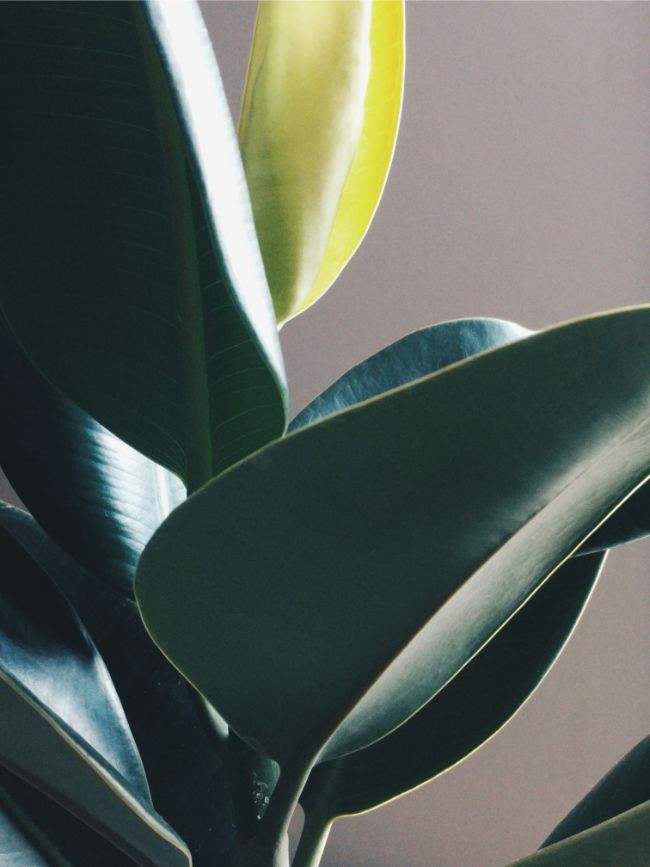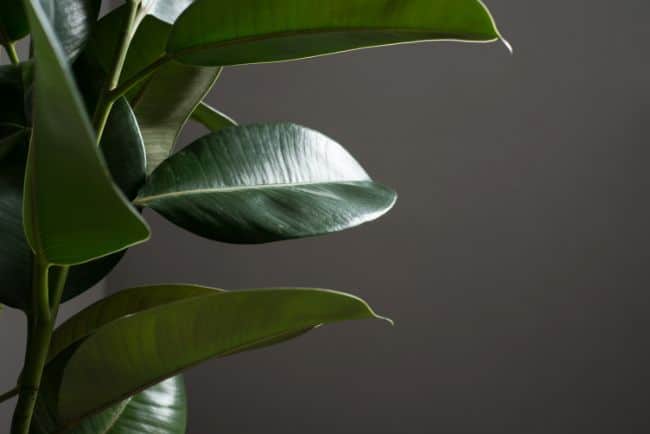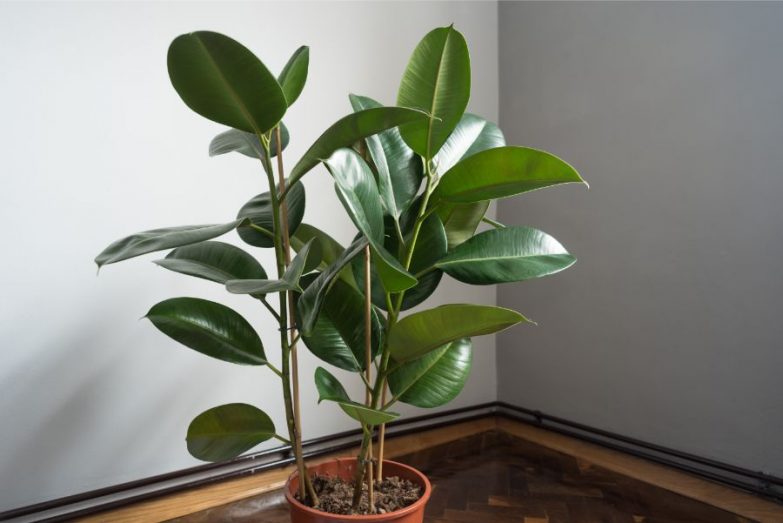Rubber Plants are a longtime favorite houseplant. As an owner, it’s distressing to lose even one of their beautiful, distinctive leaves. Unfortunately leaf shedding is a common problem. If you’ve noticed your Rubber Plant losing leaves, then read on to learn how to fix the issue and prevent it from happening again.
Why Is Your Rubber Plant Losing Leaves? The type of leaf damage can indicate the problem. Yellowed, mushy leaves signal overwatering; crispy foliage points to underwatering. Pests can cause distorted or curled leaves. Other reasons may be low light, cold shock, or acclimatization to new conditions.
Causes Of Rubber Plant (Ficus elastica) Leaf Loss
The broad leaves of this famous plant have made it popular since the Victorian age. They deserve their comeback: Rubber Plants feature the bold structure of their chart-topping cousin, the Fiddle-Leaf Fig, while being less touchy about their conditions … and, after all, they’re one of the few houseplants featured in a pop song. (Take that, Fiddle-leaf Fig!)
Rubber Plants are sturdy banyan figs that grow to enormous size in the wild – 130 feet and taller – though they stay much smaller when kept in a container. New varieties feature increased resiliency, variegation, and even burgundy leaves.
Native to Asia, Rubber Plants favor moist soil and strong indirect light. The oval leaves can reach a foot long by six inches wide; they grow largest on young plants. The plant is easy to care for once it’s acclimated to a bright spot. Read my rubber plant care guide to learn more. They grow fastest in the warm season and add about two feet of growth a year; however, they drop leaves when unhappy, and there are many reasons why.
Damaged leaves don’t recover, but they can be replaced by healthy new growth. Pruning above a leaf node stimulates new branches below the cut, making it possible to shape Rubber Plants into a bushy floor centerpiece or an indoor tree.
Overwatering
Rubber Plants have a high tolerance for drought, but they shouldn’t be treated like succulents. Their leaves droop when underwatered; however, leaf loss is more likely in a plant that’s been watered too much.
The key to keeping a healthy Rubber Plant in a container is to let them dry out slightly between waterings. The plant likes to be moist during the growing season, yet their roots need an interval to breathe. Overwatering will cause the leaves to turn yellow or brown and perhaps mushy before falling off.
Don’t water by a schedule or based on experience with other plants: feel the topsoil with your finger. Don’t water until the top inch is dry, and then douse the soil thoroughly until water runs through the drainage holes.
Some important tips:
- Make sure the pot has good drainage, and don’t let water collect in a bottom cache.
- An oversized pot can keep the soil wet for too long.
- Reduce watering to once or twice a month during the cool dormant season.
- Use room-temperature conditioned water to avoid shocking the roots. Consider using distilled water if your tapwater has high mineral content.
Read my guide to fixing overwatered houseplants for more information.
Acclimatization
Rubber Plants are hardy once established, but they tend to drop leaves after being relocated or when conditions otherwise change. Be prepared for this and don’t begin making further changes out of panic.
Don’t be surprised if a new specimen you’ve brought home starts to lose leaves. If you put the plant in a bright spot and water it correctly, the leaf loss will soon stop and new growth will begin. It may take two or three months for the plant to get back on track.
Incidentally, leaf loss also occurs when moving a Rubber Plant outside for the summer and back in again. They respond well to outdoor warmth and light, however, and such a move typically results in overall growth gains.

Transplanting Or Repotting
Tough as they are, Rubber Plants don’t like being disturbed. You can expect at least minor leaf drop after repotting or transplanting. As long as the plant has good light and is watered properly, the leaf loss should stop as it recovers.
One thing to be careful of is placing extra soil on top when transplanting. Rubber Plants like to have their upper roots just barely exposed. Also, additional topsoil can mislead you into thinking the roots are drier than they actually are.
When you repot, only go up one size – about two inches in diameter. A larger container increases the chance of overwatering and makes it harder for the plant to reestablish itself.
Disturb the roots as little as possible: the tiny roothairs can be damaged when removing soil. Just add mix below the rootball to raise it to the new pot’s height, and fill in the sides.
Pests
Damage from pests can cause leaf damage and loss. Though a healthy Rubber Plant is fairly resistant to disease and infestations, it can fall prey to aphids, mealy bugs, and spider mites. Their main susceptibility, however, is to scale.
Adult scale insects have round shells 1/8th to 1/16th inches wide and come in tan, brown, gray, or white depending upon the species. They colonize the underside of leaves and young stems, often clustering around veins. The sticky honeydew they secrete can make leaves shiny and gummy.
An attack of scale causes a loss of plant vigor, yellow leaves, and eventual leaf dropping. These tiny pests blend into the background as legless bumps, so they’re easy to miss in the early stages. Get into the habit of regularly examining your plant, especially under its leaves.
70% Isopropyl alcohol is a quick treatment. Horticultural oils and insecticidal soap work too; pyrethrin is especially effective. Regardless of which you choose, you’ll need to scrub the scale to reach under the adults’ protective shells. Repeat every four to seven days until they’re gone.
Read my guide to identifying, treating and preventing houseplant pests.
Cold Shock
Rubber Plants enjoy a wide range of household temperatures, but they’re sensitive to cold. They begin to suffer when the thermometer falls below 45°F (7C°), and exposure can trigger leaf drop. If it’s not too damaged, the plant will recover if you keep it warm and give it proper care.
Outdoors the plant is hardy in USDA Zones 9b to 12. One common way cold shock happens is when plants are outside or in an unprotected area when temperatures dip.
Drafts
A temperate fan or window breeze doesn’t normally cause leaf loss, though the plant might start shedding if exposed to an overly cold or hot draft. If the air flow is in question, move the plant to another location or divert the stream so it’s not blowing on the leaves.
Low Light
Rubber Plants like a lot of bright, indirect light. They can survive on less but tend to show their displeasure by dropping leaves and becoming leggy. A rubber plant losing leaves can also be caused by a change in light conditions.
Keep the plant within a few feet of a sunny window. Rubber Plants don’t like hot direct sun, but they can handle two to four hours of gentler rays early or late in the day. Variegated varieties need bright light to maintain their color.
An uncovered east-facing window generally works well. A west- or south-facing exposure can be fine if you give the plant protection, such as sheer curtains, or move it a few feet from the window.

Overfertilizing
A rubber plant losing leaves can be a sign of overfertilizing. You don’t have to fertilize a Rubber Plant heavily: some growers feed only once a year in the spring. Others give the plant a balanced fertilizer at ½ dilution every month during the warm months. In any case, stop fertilizing over the winter dormant season.
If you overfertilize a stressed plant, the roots can be shocked enough to cause leaf loss. Sometimes the salts of residue fertilizers build up and toxify the soil to the same effect. If you’ve ruled out other causes of leaf drop, it might be a good idea to flush the soil.
It’s an easy process. Put the plant in a location it can drain freely, and water it from the top. Make sure a substantial amount of excess water comes through the drain holes. Let the pot fully drain and perhaps do it a second time. Wait until the top two inches of soil dries out before rewatering.
A yearly flush is a good horticultural practice. It’s best to do it every few months if you’re fertilizing more often.
Read my complete guide to fertilizing houseplants for more information.
Low Humidity
Rubber Plants originally come from humid habitats, but they do well with less air moisture if its other conditions are met. They may lose their lower leaves a little faster if the air is dry, but average indoor humidity doesn’t unusually trigger significant shedding.
Some growers mist the leaves, but this won’t raise humidity long enough to make a difference. Keeping pebble-filled trays of water under or near the plant will help more. Just make sure the bottom of the pot is above the waterline! Learn more about the best ways to improve humidity for your indoor plants here.
Natural Loss Of Old Foliage
Old leaves drop naturally from the base of the plant as they mature. You can’t do anything about it. Great light and optimum care may delay the progression, but Rubber Plants naturally assume a tree-like structure as they grow. To fight Nature you’ll have to prune to promote new branches.
Tips To Prevent Your Rubber Plant Losing Leaves
- Don’t overreact to losing a few leaves … just be sure the plant is pest-free, you’re watering correctly, and the light is sufficient. Rubber Plants bounce back.
- If you’ve recently acquired your plant, it’s possible the damage you’re now seeing is due to improper care it had before. It can take time for the results of poor treatment to show up.
- Dust on leaves can block light; a dirty plant isn’t getting the amount you might think. Wipe the leaves with room-temperature conditioned water. The plant will breathe better and look healthier, too.
- Remember that pruning is less traumatic to a plant than repotting. The plant’s sap is mildly poisonous to pets and people and may irritate your skin, so wear protection.
- New leaves won’t emerge from bare branches on your Rubber Plant, but they will grow from the end of a pruned stem.
- Strong light is often a panacea for a Rubber Plant. It boosts recovery and helps the plant grow quickly to replace its losses. If you see healthy, well-formed new leaves emerging, you’re on the right track.

